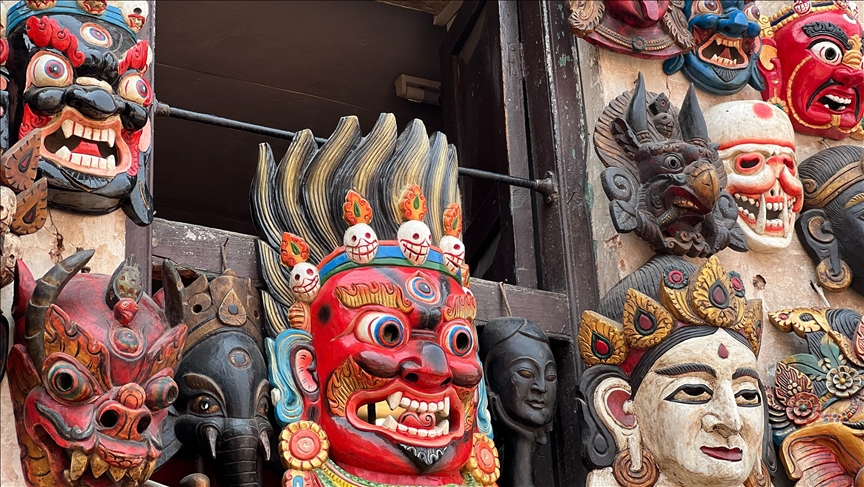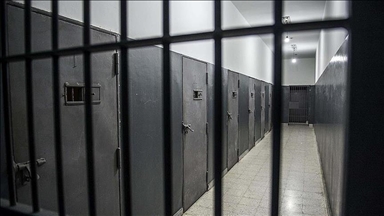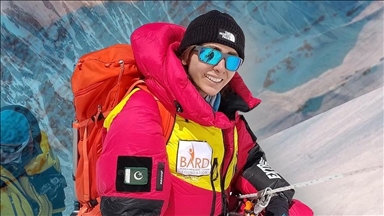Shifting sands of time: Nepali antique dealer reflects on a changing Kathmandu
Influx of tourists has opened new worlds for locals, changing lives and livelihoods

- From a hippie hotspot to a gateway to daunting peaks, Nepali capital has undergone massive transformations over the past few decades
KATHMANDU, Nepal
Sheetal Adhikari is not your typical shopkeeper. Over three decades, he has transformed his modest family store in Nepal’s capital Kathmandu into a treasure trove of unique finds, breathing new life into what others cast aside.
“It’s all about having an eye,” says the sexagenarian proprietor, who still looks very young, his voice echoing through the dimly lit shop.
“Otherwise, trash remains just that.”
There is a certain mystique to Adhikari’s shop in Thamel, Kathmandu’s bustling tourist quarter.

The air hangs heavy with an earthy scent, dust motes dance in the faint light filtering through the windows, and shelves groan under the weight of fascinating knickknacks.
Carved Hindu masks and wooden animal sculptures share space with delicate glass vases, shamans’ necklaces, and a captivating collection of talismans and idols.
“This isn’t just a place of business for me,” Adhikari explains, his gaze sweeping over his collection.
“This is my home. I live surrounded by these old treasures.”
His eyes sparkle as he recalls his first glimpse of Kathmandu Valley in the 1980s. Hailing from a remote village in Langtang Valley, the young Adhikari had never known life beyond the rugged mountain trails.
“Fetching water itself was an hourlong trek, through paths littered with leaves and stones,” he told Anadolu.
“Kathmandu, with its magical taps that gushed water, seemed like a dream.”
His father, a porter by trade, was a beneficiary of the Himalayan expeditions boom of the 1960s. Back then, reaching Lukla, the gateway to Mt. Everest, meant a grueling seven-day trek from Jiri, a small town in central Nepal.
“For months during the climbing season, my father would be gone,” Adhikari said. “One year, he returned early, with a broken rib that sidelined him for good.”
With their arid village offering few opportunities, and his father’s career cut short, a life-changing decision was made as the family packed up and headed to Kathmandu.
Winds of change open doors of opportunity
His father valiantly tried various professions, but none seemed to hold.
Then, amid the challenges, a new chapter in their life began in the vibrant heart of the capital.
The 1970s ushered in a period of dramatic change for the Kathmandu Valley. The iron grip of the Rana dynasty had loosened, replaced by a fledgling democracy – a novelty for the region’s inhabitants, even with a monarch at the helm.

This newfound freedom sparked a wave of modernization, transforming not just the city’s infrastructure but also its way of life.
The winds of change swept through aristocratic households as well. As families embraced modern living, they shed the trappings of the past. Out went the age-old clutter – discarded furniture, forgotten statues, and dust-laden paintings.
This, for young Adhikari’s father, presented a golden opportunity.
He began collecting this junk – a broken leg from a centuries-old bed, a tarnished statuette, a faded painting – each imbued with the valley’s rich history.
These discarded treasures proved to be a windfall. Streetside stalls selling these curios to Western tourists with a fascination for the exotic flourished, and Adhikari’s father was at the heart of it all.
He quickly amassed a fortune, enough to purchase a small house with a shop in Thamel.
The late 1970s and 1980s witnessed Kathmandu’s transformation into a global city. It all began with a wave of hippies who arrived in the early 70’s, drawn by the allure of the Bhakti movement and the ancient Silk Road. Their unconventional lifestyle ignited a spark of westernization and liberalization among Kathmandu’s residents.
The city responded with a touch of the West. Pop joints sprouted up, offering a taste of the new – branded clothing, automobiles, and all the rest associated with this new wave.
This cultural exchange was not one-sided.
The demand for antiques soared and shops brimmed with treasures – intricately carved wooden “mangalsutras,” or wedding necklaces, captivating idols, and more – all selling like hot cakes.
Adhikari, backed by his father’s small yet growing antique trade and with a keen eye for opportunity, thrived in this new atmosphere.
“The wave of Western tourism kept building,” he recounts.
“The ‘80s saw travel agencies blossom, offering treks and tours to the world, unveiling Nepal’s hidden gems. It solidified Nepal’s reputation as the ultimate adventure destination.”
The rise of mountain climbing
Commercialization of mountains like the Eight-Thousanders – the peaks standing taller than 8,000 meters (26,247 feet) – boomed.
High-altitude trekking in the Himalayas became the new rage, and Kathmandu, the gateway to these adventures, was flooded with vacationers and adventurers.
This influx directly helped Adhikari grow his business: “Tourists flocked to the city, and many found their way to my shop.”
His focus shifted to acquiring unique souvenirs beyond antiques.
He ventured out, sourcing local musical instruments, ornately carved wooden boxes, gleaming copper vessels, intriguing tribal figures, and even ancient treasures like bells, manuscripts, traditional clothing, and fascinating artifacts like “bhote talchas,” or antique locks, and “mana pathis,” which are sets of measuring vessels.
According to Adhikari, the world of antiques is a fascinating yet challenging one, as pinpointing an object’s exact age can be near impossible.
“We used to rely on patina,” he explained, referring to the sheen that develops on an object over time. “But even that’s unreliable now, as it can be artificially created.”
Thankfully, he said, most tourists prioritize the object’s appeal over absolute authenticity.
Prices vary widely as musical instruments can range from a few hundred Nepali rupees to over 10,000 rupees ($75). A human femur bone trumpet, known as a “kangring,” might fetch around 6,000 rupees ($45) at his shop.
Adhikari’s business is not one-way traffic, as people often approach him with items for sale.
His keen eye and knowledge of current trends determine his offer.
“Unreasonable margins don’t work,” he admits. “Competition is fierce with so many shops around.”
Currently, his on the hunt for “dhungros, or milking pails, particularly older ones from eastern Nepal.
The world of antiques can also be a minefield.
Metal statues require extra caution due to strict regulations. Stolen idols from Nepal have made headlines, and Adhikari remembers a time when news of pilfered temple treasures was commonplace.
Even caretakers, including priests, were implicated, often under the protection of powerful figures.
“Before 1950, there were no clear laws,” Adhikari explained.
“Antiques were easily exported. Then came the Ancient Monuments Preservation Act in 1956. It restricted the export of objects over a century old and idols … as they’re considered living cultural heritage.”
Anadolu Agency website contains only a portion of the news stories offered to subscribers in the AA News Broadcasting System (HAS), and in summarized form. Please contact us for subscription options.







